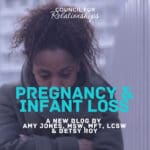Pregnancy and Infant Loss Awareness
Each October, Pregnancy and Infant Loss Awareness Month offers space to reflect on the grieving process and honor families who have experienced traumatic loss. This piece explores the emotional realities of pregnancy and infant loss—how grief unfolds, what support can look like, and ways to find healing through compassion and connection.

Get matched with a CFR Therapist today.
Understanding Pregnancy and Infant Loss
“What we once enjoyed and deeply loved we can never lose, for all that we love deeply becomes a part of us.” — Helen Keller
Grief tends to ebb and flow throughout the year. Seasonal shifts can give us time to reflect, or we may feel overwhelmed with memories and hopes that feel lost. October is Pregnancy and Infant Loss Awareness Month (PAILM). As the weather cools, emotions can sharpen and fluctuate. Losing an infant is traumatic. Grief after such loss can feel destabilizing and isolating. Individuals may feel uncertain, angry, guilty, devastated, or all of these at once. There is no “right” way to grieve.
While infant loss can lead to profound isolation and depression, we want you to know that you are not alone. Just as there’s no single way to grieve, every story of loss is unique. Sitting with grief takes tremendous strength. As a society, we are not adept at discussing or holding space for loss. Definitions of grief can feel limiting or exclusionary.
Pregnancy and infant loss affect families of every background, but it does not affect all communities equally. Black, Indigenous, and other people of color experience significantly higher rates of pregnancy complications and infant mortality, not because of differences in biology, but because of longstanding inequities in access to quality healthcare and culturally responsive support. Naming these disparities allows us to work toward a world where every family has an equal chance at a healthy outcome, and every experience of loss is met with dignity and care.
The Grieving Process after Pregnancy and Infant Loss
Disenfranchised grief refers to grief that cannot be openly acknowledged or mourned in community. There is no timeline for grief, and no one’s grief is more “real” than anyone else’s. Your experience, your story, is valid.
Forms of Pregnancy and Infant Loss
We honor all those who have experienced pregnancy and infant loss, in whatever form that takes, including:
- Termination for medical reasons (TFMR): A deeply personal and often heartbreaking decision, representing about 4% of terminated pregnancies. Mental health support, including EMDR, can be healing for individuals and couples.
- Infertility: The inability to conceive or maintain a pregnancy or experiencing impaired reproductive function.
- Miscarriage: The loss of a pregnancy before 20 weeks’ gestation.
- Stillbirth: The death of an infant in the uterus or during delivery.
- Sudden Infant Death Syndrome (SIDS): The unexpected death of an infant, often during sleep, with no known medical cause.
- Loss during the first year: The death of a baby in infancy, from any cause.
- Or any definition of loss that feels true to your experience.
Traumatic Loss: Navigating Emotions after Pregnancy and Infant Loss
Pregnancy and infant loss are prospective losses, meaning you may grieve not only what was, but what could have been. The future you envisioned and hoped for may now feel out of reach. For many, there are two stories: the one you share with others, and the private story you tell yourself.
Grief is nonlinear. It changes day to day, season to season. It is natural to feel confused, numb, or even surprised by your emotions. Your feelings may change every day. You may be surprised by your feelings.
Triggers, Emotional Swings, and the Grieving Process
You may have experiences that trigger grief and/or traumatic feelings in daily life such as baby clothes in a store aisle, being around pregnant friends and family members, or well-meaning comments. Emotional swings and dysregulation are common. There is nothing wrong with you if these moments feel overwhelming.
Common Thoughts when Grieving a Traumatic Loss
Common negative thoughts and themes when grieving a traumatic loss may include:
- Safety & Vulnerability: “I couldn’t keep my baby safe.”
- Responsibility & Shame: “I’m not meant to be a parent.”
- Choice & Helplessness: “Did I make the right decision?”
- Belonging & Isolation: “Will I still be accepted by my friends with young children?”
You are not alone in these thoughts and feelings. Connection through therapy, support groups, community, or creative expression can help soften isolation and bring healing and shift these negative cognitions to adaptive beliefs.
“Sometimes She Visits Me in My Dreams”
In my dreams she is never actually a person
Just a potential
A boulder in my belly
A poem from my lips
She is never quite here
Having never truly arrived
She is always leaving
In some shape or form
Formless
My two-week old daughter visits me
And I feel her
Know we had a connection
However brief it may have been
-Yazmin Monet Watkins from A Vessel Born to Float
Finding Support after Pregnancy and Infant Loss
People who will listen and be with you without judgement can create safe spaces to sit with the loss. Supportive friends, family, and coworkers can reduce feelings of isolation. Understanding your partner’s grief can strengthen your bond. There is no single roadmap for navigating loss; each person’s emotional process is unique. Yet, knowing what you need, or how to ask for it, can feel impossible. Give yourself and your partner permission to grieve in your own ways, at your own pace.
Some couples who’ve experienced infant loss wonder if they can consider themselves parents. Some distance themselves from the title, while others embrace it as part of their story. When parents terminate a pregnancy for medical reasons, many describe the decision as an act of love: taking on pain so their child would not have to suffer.
Reading others’ stories can also bring comfort, providing language for emotions that feel hard to name. For some, faith or spiritual practice is grounding; for others, creativity or nature becomes a refuge.
How Therapy—Including EMDR—Supports the Grieving Process
Therapy is not a “cure” for grief. However, it can be a unique space where the traumatic components of the loss can be processed, so that parents can begin the adaptive grief process more naturally and fully. You don’t have to carry this alone. You are not broken. You deserve support, safety, and space to honor your grief in a way that feels authentic to you.
Eye Movement Desensitization and Reprocessing (EMDR) is one type of therapy that offers a compassionate and effective approach to processing the traumatic components of experiences (for example visuals, smells, sounds, negative thoughts, intense emotions) of infant loss. EMDR helps remove barriers that block the natural grieving process. Over time, people often find their emotions soften and their sense of peace expands, even though the loss remains part of them.
Self-compassion may feel hard to hold, but you deserve the same love and tenderness you would offer a dear friend. Give yourself permission to feel without judgment.
Honoring Grief and Reconnecting with Love after Traumatic Loss
“When we lose our tolerance for vulnerability, joy becomes foreboding,” writes Brené Brown about “foreboding joy” in her 2012 book, Daring Greatly. In our work as therapists, we often meet parents caught in this tender tension: longing to feel joy again yet fearing that joy will make them vulnerable to the exhaustion and excruciating pain of loss. After pregnancy or infant loss, this fear makes perfect sense. Love and pain have become so closely linked that even moments of peace or hope can stir anxiety.
Our intention this month is to name that experience, separate out the traumatic components of the experience, honor and make space for the grief beneath it, and offer ways to gently reconnect with love, even when loss has made it feel unsafe. As lonely as you may feel, you are not alone. Council for Relationships and Women’s Psychological Health Services offer therapy for individuals, couples, and families, as well as medication management.
It takes courage to acknowledge your pain. Courage to sit with hurt. Courage to lean on a partner, a friend, or a therapist. And courage, too, to wait until you’re ready. Grief unfolds on its own timeline. Wherever you are in your process, know that you are not alone.
Editor’s Note: The views expressed in this blog are those of the author and do not necessarily reflect the official policy or position of Council for Relationships.
Women’s Psychological Health Services at Council for Relationships
Council for Relationships’ Women’s Psychological Health Services (WPHS) provides compassionate, specialized care for women navigating life transitions, grief, and loss. Our therapists support individuals and families through the grieving process after pregnancy and infant loss, helping them heal from traumatic loss with empathy and expert guidance. Get matched with a WPHS therapist today to begin your journey toward healing.
About the Authors
Amy Jones, MSW, MFT, LCSW, is a Staff Therapist and Director of Women’s Psychological Health Services at Council for Relationships. Amy is accepting new clients—contact her to schedule a free 15-minute consultation.

Betsy Roy is a CFR Clinical Intern and offers low-fee therapy under the supervision of a licensed CFR Staff Therapist.
Betsy Roy is a Clinical Intern at CFR from Temple University. She offers low-fee therapy services for those seeking support. Contact our Client Care team to learn more.
More from CFR
- Check out our blog for expert insights and stories on emotional well-being.
- Get matched with a CFR therapist or psychiatrist today.
- Sign up for our newsletters to stay connected with mental health resources and events.
New Parents, Social Media & Pregnancy: What You Need to Know
Disenfranchised Grief: How the Passing of My Cat Made Me a Better Therapist

